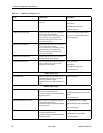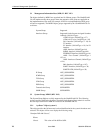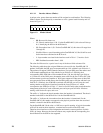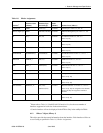
1. Network Management Specification
8000-A2-GB30-00 June 2003
17
3.2.2 “sysObjectID” Object (system 2)
This object provides the authoritative identification of the network management subsystem
contained in the unit. This object will be set to display the following object identifier:
sme-chassis-8820[Company Enterprise OID].1.14.9.14.5.1
sme-chassis-8620[Company Enterprise OID].1.14.9.14.5.2
3.2.3 “sysUpTime” Object (system 3)
The time (in hundredths of a second) since the network management portion of the system
was last reinitialized.
3.2.4 “sysContact” Object (system 4)
The textual identification of the contact person for this managed node, together with
information on how to contact this person. If no contact information is known, the value is
the zero-length string.
3.2.5 “sysName” Object (system 5)
An administratively-assigned name for this managed node. By convention, this is the
node’s fully-qualified domain name. If the name is unknown, the value is the zero-length
string.
3.2.6 “sysLocation” Object (system 6)
The physical location of this node (for example, ‘telephone closet, 3rd floor’). If the
location is unknown, the value is the zero-length string.
3.2.7 “sysServices” Object (system 7).
This object provides a value which indicates the set of services that are potentially offered
by the DSL unit. The value is a sum. This sum initially takes the value zero. Then, for each
layer L in the range of 1-7 (for 7 OSI layers) that this node performs transactions for,
2 raised to L-1 is added to the sum. For example, a node performing only routing functions
would have a value of 4(z^(3-1)). In contrast, a node which is a host offering application
services would have a value of 72 (2^(4-1) + 2^(7-1)). Note that in the context of the Internet
suite of protocols, values should be calculated accordingly. For systems including OSI
protocols, layers 5 and 6 may also be counted.
The following table shows the values supported :
Table 1-5. sysServices
Layer (L) Functionality Value(2^(L-1) Sum
1 Physical 2^(1-1) = 2^0 = 1 1
2 DataLink/Subnetwork 2^(2-1) = 2^1 = 2 3
3 Internet 2^(3-1) = 2^2 = 4 7
4 End-to-End 2^(4-1) = 2^3 = 8 15
5 Session 2^(5-1) = 2^4 = 16 31
6 Presentation 2^(6-1) = 2^5 = 32 63
7 Application 2^(7-1) = 2^6 = 64 127





















